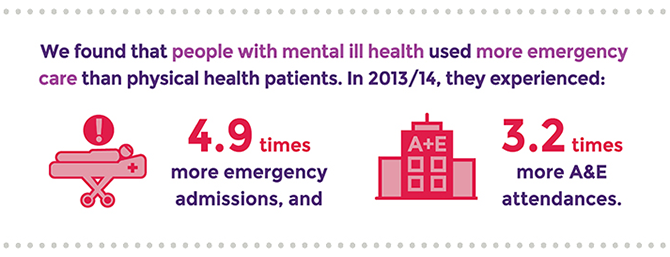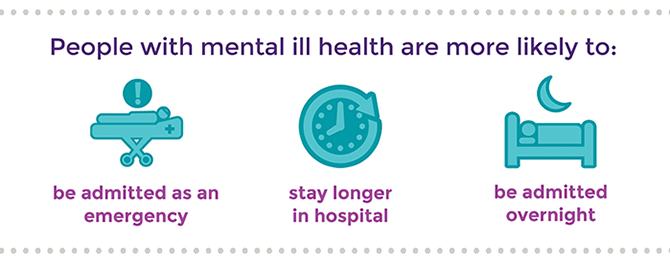At any given time, one in six adults has a mental health problem. This can include disorders such as depression, anxiety or phobias; or feelings and behaviours such as panic attacks or self-harm. Roughly one in a hundred people will have a serious mental illness. This includes more severe conditions such as schizophrenia or bipolar disorder.
What’s physical health got to do with it?
Mental health problems do not occur in isolation: it’s estimated that 46% of people with mental ill health also have a long-term physical condition. This means that conditions such as obesity, diabetes, respiratory disease and coronary heart disease are more common in people with mental ill health.
The result is a group of patients who have generally poorer physical health and very complex care needs, many of whom die much younger than the general population. For those with the most severe needs, people under 75 with a serious mental illness can die between 10 and 17 years earlier.
Research has shown that the reasons why people die earlier are not usually a direct consequence of their mental health, but are often linked to poor physical health. Increased risk factors (such as smoking or alcohol), the impact of some mental health medications, and poor access to physical healthcare all contribute to this.
We looked at all hospital users between the age of 18 and 75 over a five-year period – this amounted to roughly 100 million care events each year.
So far, much of the research in this area has focused on people with serious mental illness. But we wanted to understand how people with all types of mental ill health use hospital services, in particular in relation to their physical health needs.
Who’s behind the numbers?
Using hospital episode statistics data, we looked at all hospital users between the age of 18 and 75 over a five-year period – this amounted to roughly 100 million care events each year. We looked at two groups of patients: those who’d used a hospital service for support with mental health needs and people who had no previous record of mental health service use. We then looked at their subsequent hospital use.
Here, patients with mental ill health could include people who had experienced any amount of mental health care. This could range from lighter touch support, such as one-off counselling appointments, to more intensive hospital stays on a psychiatric unit or crisis ward.
What did we find?
Looking solely at support for physical healthcare, our findings suggest that people with mental ill health are not having their physical health well managed, resulting in high emergency care use. This is despite a number of recent national care guidelines and policies targeting the improvement of physical healthcare for those with mental ill health.

We also found that for some common procedures people with mental ill health were more likely to have an emergency rather than planned admission, be admitted overnight and stay longer in hospital. For example, for people with mental ill health who had a hip replacement, 40% experienced an emergency rather than planned admission; whereas for people without mental ill health, just 8% of these admissions were an emergency. Higher emergency presentations rather than planned admissions for common physical health procedures could indicate that these physical health needs are not being identified.

Unhelpful barriers or necessary distinctions?
Underlying our findings are the limitations that come from treating mental health in isolation from physical health. These system-wide barriers mean that it’s often confusing to know who’s responsible for supporting the physical health care of people with mental ill health.
For some patients, missed physical health needs could result from either a lack of engagement with generalists in primary care, or nurses and GPs not identifying their needs. Within mental health care, it may be that specialist clinicians lack the necessary training and skills to identify and support physical health needs.
These gaps will in part result from clinicians making the necessary decision to treat a patient’s most severe needs first – for some, they will have reached hospital at a time of crisis for their mental health, meaning that follow-up care looking at their overall needs will not be a priority at that time. Patients may also be reluctant or unable to adopt lifestyle and behaviour changes during, or soon after, a time of crisis which could improve their overall health.
As it currently stands, we are often forced to think about either ‘mental’ or ‘physical’ health yet, for all of us, these two elements are intricately and inseparably linked. I would challenge the ‘physical’ and ‘mental’ health tags as it results in important care needs being missed. Ultimately, no one should need to choose.
